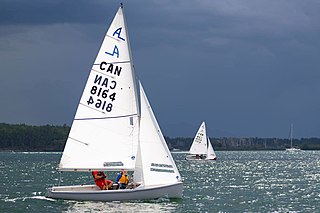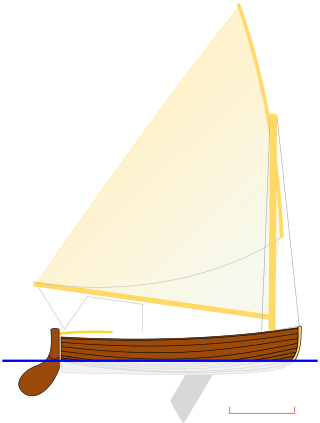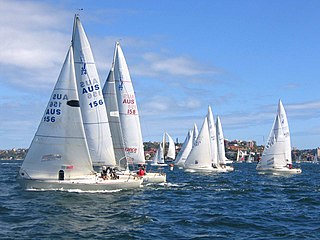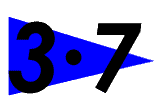
Dinghy sailing is the activity of sailing small boats by using five essential controls:
The Mirror is a type of popular sailing dinghy with more than 70,000 built.

Dinghy racing is a competitive sport using dinghies, which are small boats which may be rowboats, have an outboard motor, or be sailing dinghies. Dinghy racing has affected aspects of the modern sailing dinghy, including hull design, sail materials and sailplan, and techniques such as planing and trapezing.

The Albacore is a 4.57 m (15 ft) two-person planing dinghy with fractional sloop rig, for competitive racing and lake and near-inshore day sailing. Hulls are made of either wood or fiberglass. The basic shape was developed in 1954 from an Uffa Fox design, the Swordfish. Recent boats retain the same classic dimensions, and use modern materials and modern control systems.

The Laser is a class of single-handed, one-design sailing dinghies using a common hull design with three interchangeable rigs of different sail areas, appropriate to a given combination of wind strength and crew weight. Ian Bruce and Bruce Kirby designed the Laser in 1970 with an emphasis on simplicity and performance.
Boat racing is a sport in which boats, or other types of watercraft, race on water. Boat racing powered by oars is recorded as having occurred in ancient Egypt, and it is likely that people have engaged in races involving boats and other water-borne craft for as long as such watercraft have existed.

The 470 (Four-Seventy) is a double-handed monohull planing dinghy with a centreboard, Bermuda rig, and centre sheeting. Equipped with a spinnaker, trapeze and a large sail-area-to-weight ratio, it is designed to plane easily, and good teamwork is necessary to sail it well. The name comes from the boat's length of 470 centimetres.
Alexander Stuart "Jock" Sturrock MBE was a noted Australian yachtsman who won over four hundred international, national, state and club championship yachting races.

The International 505 is a One-Design high-performance two-person monohull planing sailing dinghy, with spinnaker, utilising a trapeze for the crew.

The Cherub is a 12 feet long, high performance, two-person, planing dinghy first designed in 1951 in New Zealand by John Spencer. The class is a development class, allowing for significant variation in design between different boats within the rule framework. The minimum hull weight was originally 110 lbs.
Fernando Echávarri Erasun is a professional yachtsman in the Olympic Tornado class. Teaming with crew Antón Paz Blanco, he became the Spanish, European, World Champion, ISAF Sailor of the year in 2005, Olympic gold medallist at the 2008 Summer Olympic Games held in Qingdao.
Iain Murray is an Australian sailor and yacht designer
The 29erXX is a high performance sailing skiff, it was designed to allow light crews, particularly female crews, to sail twin trapeze boats and as a training boat for the more powerful 49er. The class gained International Sailing Federation Class status in May 2011, but lost it in 2014.

The Twelve Foot Dinghy was designed by George Cockshott, an amateur boat designer from Southport, England in response to a 1912 design contest. It became the first one-design racing dinghy to achieve international recognition. The class was granted the 'International' status by the IYRU in 1919 and remained this status until 1964 when it was revoked by the same authority. The class was selected as the dinghy class for the Olympics in 1920 & 1928. In 1924 the French wanted to use an alternate French design.
The Naples Sabot is an 8-foot (2.4 m) sailing dinghy. The Naples Sabot was designed by Roy McCullough and R.A. Violette and the first two were built in Violette's garage during WW II, although official designs were not made available until 1946. The Naples Sabot is based on the Balboa Dinghy and on Charles MacGregor's Sabot as published in Rudder magazine, April 1939. It takes its name from Naples in Long Beach, California, where it was developed.

The sport of sailing involves a variety of competitive sailing formats that are sanctioned through various sailing federations and yacht clubs. Racing disciplines include matches within a fleet of sailing craft, between a pair thereof or among teams. Additionally, there are specialized competitions that include setting speed records. Racing formats include both closed courses and point-to-point contests; they may be in sheltered waters, coast-wise or on the open ocean. Most competitions are held within defined classes or ratings that either entail one type of sailing craft to ensure a contest primarily of skill or rating the sailing craft to create classifications or handicaps.

The International Cadet Australian Championship is an annual series of championship races held in Australia as the top racing event for the Cadet class sailing dinghy in the country. Generally held as a qualifier for the world cup, the championship will reach its 50th event in 2011 when it will be held at Lake Macquarie in New South Wales from 27 December 2011 to 4 January 2012.

The Wētā 4.4 Trimaran is a 4.4 metre sailing dinghy conceived and developed in New Zealand from 2001-2006 by Roger and Chris Kitchen and others with original drawings by TC Design's Tim Clissold.

The Farr 3.7 is a one-person sailing dinghy designed by Bruce Farr in 1971. The design plans are sold by the 3.7 Class Owners Association and they are built by a mix of professionals and home built by amateurs. The 3.7 Class is recognised by Yachting New Zealand as a national class and yachts are sailed in New Zealand, Australia and Great Britain. Full sets of plans have been sold worldwide to a number of individuals with greatest numbers in Germany, Japan, USA, South Korea, Poland, France, Belgium, Russia, Spain, Uruguay.

Alan Newbury Payne AM was a naval architect born in England but who worked in Australia. His yacht designs were readily built by both professionals and amateurs, and remain well represented in the ocean-going and coastal yacht fleet.













